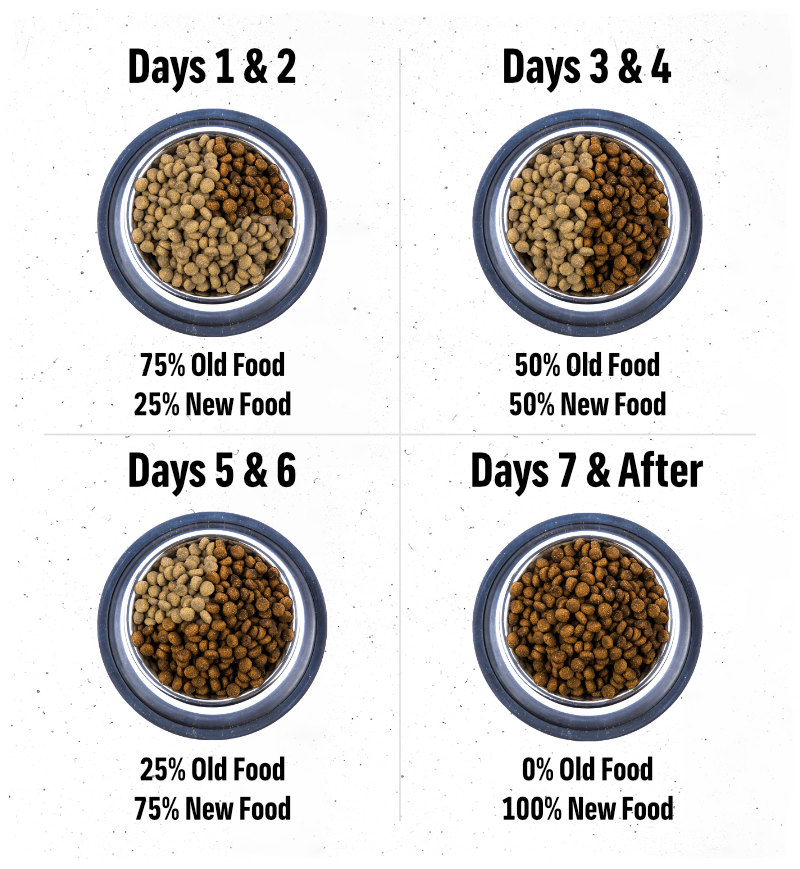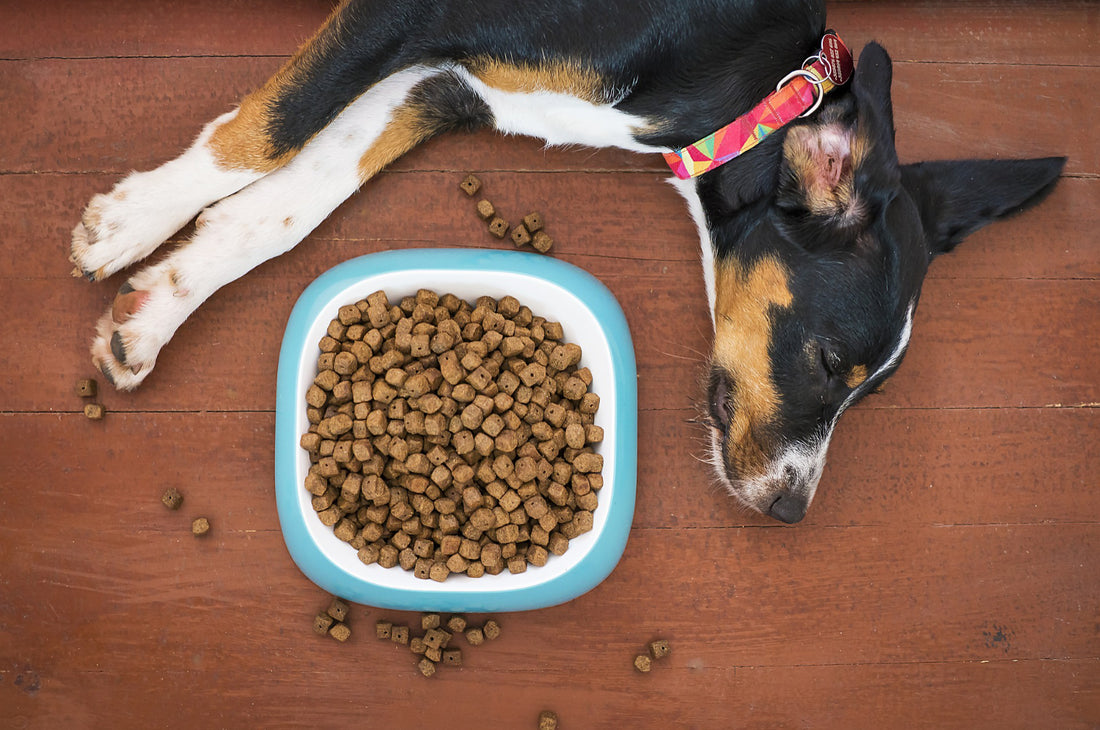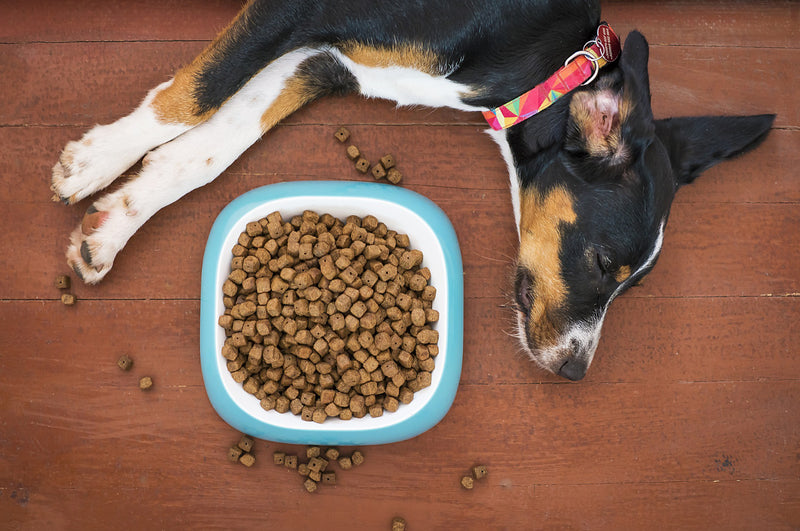Have you heard that changing your dog’s food will make them sick?
This is actually a commonly-held misconception. It's a myth that stems from one of the oldest marketing plays in the pet food industry. The goal was to make it less likely that a dog owner would switch up the food they gave their dog.
While it’s not unusual for a sudden and drastic change in diet to be messy if it’s done too quickly or if your dog has a food intolerance, changing your dog’s food from time to time can actually be a healthy practice.
That being said, transitioning to a new dog food formula can be a little scary. If you’ve tried to change your dog's food before with messy results, you might be hesitant to try again. But it’s often well worth the effort (as long as it’s done correctly). Having a healthy variety in your dog’s diet by transitioning them onto a new food from time to time makes it much less likely that they will develop any stubborn food intolerances. Plus, the more often you successfully make transitions, the more resilient your dog’s digestive system becomes. Making them better able to digest a wider variety of foods and treats!
Want to avoid the nasty symptoms of improperly transitioning your dog onto a new food? Let’s walk through the process. We think you’ll discover that switching dog foods isn’t really that scary after all.
Benefits of Transitioning to a New Dog Food
When you transition your pup to a new type of dog food, there are some benefits you might notice right away. For instance, the new food may be better suited to your pup’s nutritional needs. This could lead to healthier skin and coat, more energy, less stomach issues, and a generally happier pup.
This isn’t the only reason to switch up your dog’s food, however. Many folks switch onto new dog food because they want to feed better quality ingredients, and an easier to digest formula. Some dog owners are looking to target specific areas of health like skin & coat or aching joints in aging pups. Something as simple as a change in flavor can help to stave off boredom and make mealtimes more exciting. Additionally, switching to high-quality food can help to improve nutrient absorption, which in turn can help to strengthen your pup’s immune system.
How to Choose the Right New Dog Food
Choosing the right dog food for your pup can be a challenge. There are so many different types of food on the market, and it can be difficult to know which one is best for your pup.
It’s important to know the food you're transitioning from in order to choose the best food to transition to. You should get familiar with the ingredients on any potential dog food label as well as the guaranteed analysis that can be found on the back of the bag somewhere. If your dog is eating a low-protein, low-fat formula, you might have more trouble with a sudden transition straight onto a high-protein formula. While this doesn’t mean you should avid feeding a higher protein formula (there are many reasons you would want to do just that for many different dogs), you should be aware that, until the transition is complete, you may encounter more digestive upset than usual.
This is because dogs have specific digestive enzymes that are required to break down and absorb different types of nutrients, including proteins, fats, and carbohydrates. The ingredients they consume most often are what their system tunes itself to. When a dog is consuming a low-protein diet, their digestive system may not be accustomed to breaking down and digesting significantly higher levels of protein.
Switching to a high-protein diet too quickly can overwhelm their digestive system for a time, leading to symptoms like diarrhea, gas, and stomach pain. This is particularly true if the new food is significantly higher in protein content than their previous diet. Their system needs time, and resources to get used to the new formula.
(By the way, if your start a course of probiotics three days before introducing the new food, they will make a world of difference in making this transition process as smooth as possible)
Similarly, if your dog has only ever eaten a single type of protein (chicken, for example) they might have a little more trouble digesting a protein like beef at first. Again, these are not reasons to avoid certain formulas, but they are important to know so that you can supplement your dog’s diet appropriately.
You should also be on the lookout for quality ingredients. The reason that you’re changing foods in the first place is probably that you want your dog to eat a higher-quality diet or you’re trying to avoid specific ingredients common in pet food like corn or any sort of by-product. So when choosing a new food for your dog, be sure to prioritize high-quality, whole ingredients that promote their overall health.
Finally, you should consider the ability to do rotational feeding. This is when you are able to feed multiple formulas, and multiple types of food (like wet food, raw food, or freeze-dried), often from the same brand, without needing to do a transition period. Our Kahoots grain-free dog foods (beef and salmon) for example, are designed to be fed interchangeably. Same with our grain-in formulas (chicken and lamb). Additionally, our wet food and tasty toppers are simple add-ins to create a healthy rotational diet.
Rotational feeding is a strategic way to limit the possibility of your dog developing a food intolerance or nutritional deficit that can happen when they eat only a single formula for a long period of time. These diets also help to break the boredom of eating the same old thing every dat, bring fun and excitement to mealtimes, discourage picky eating, and make shopping easier (if the store is out of your staple food, you can substitute another formula without issue).
How to Transition Dog Food: A Gradual Approach
How, exactly, do you transition your pup from one dog food to another? Gradually. You transition dog food slowly.

Over the course of a week, you’ll need to mix an amount of their old food, with some of the new. Gradually, you’ll increase the percentage of new food your dog gets. The transition schedule looks like this:
For days one and two: your dog’s diet should be approximately 25% of the new formula, and 75% of the old formula.
For days three and four: your dog’s diet should be approximately 50% of the new formula, and 50% of their old formula.
For days five and six: your dog’s diet should be approximately 75% of the new formula, and 25% of the old formula.
And for days 7 and beyond: your dog’s diet can be 100% made up of their new formula!
This is true for dry dog kibble, wet dog food, raw food, and freeze-dried food—whatever your dog’s primary diet is, that food can be transitioned using this schedule. Though, we should note that this is a general recommendation and you can personalize the schedule based on how your dog reacts to the new food. If they’re having a significant amount of digestive upset, keep them eating more of their original food for longer. If they’re tolerating the new food just fine, than you can stick with the schedule as outlined.
Monitoring Your Dog's Health During the Transition
Now, during the transition period, you can still expect to run into some hiccups (even with a schedule and a gradual transition). Any amount of brand new dog food has at least some potential to cause digestive upset. So it’s important to watch for any signs and be ready to adjust your approach. Look for any vomiting, abnormal gas, or changes in your pup’s poos.
If your dog's bowel movements are soft or runny, you can add pumpkin puree (up to 1 TBS per 10lbs body weight) to each meal until they firm back up. Continue using the pumpkin through the next new food percentage increase. This can keep your pup on track through the transition while helping to alleviate the worst of their digestive issues. It’s also a good idea to keep your dog on a regimen of probiotics throughout the process.
On the other hand, if your dog is vomiting digested food (not still recognizable), or having liquid diarrhea, stop all new food and wait a few days before trying again with a smaller amount of new food.
Iif your pup continues to be uncomfortable or is having continuing trouble adjusting, you may need to speak with your vet for advice.
Wrapping Up: Making a Seamless Dog Food Switch
Making the switch to a new dog food doesn’t have to be a difficult process. With the right information and a few simple steps, you can make a successful and seamless transition for your pup.
Just make sure to do your research on the dog food you’re switching to and transition gradually. Take things slow as you monitor your pup for any signs of digestive upset. With a bit of patience, you and your pup will make a successful transition to new dog food.


